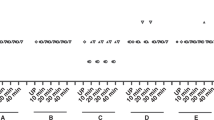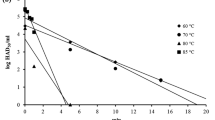Abstract
Consumption of raw or unpasteurized milk is a risk for the consumers because indirect contaminations such as fecal-cross-contamination could occur and determine the presence of enteric viruses. In this study, milk was treated with several temperature and time combinations chosen by performing a preliminary experiment to evaluate the intervals needed to inactivate Hepatitis A virus (HAV) HM175 strain, noroviruses genogroups I and II (GI and GII), and simian rotavirus SA11 at different temperatures. Results were obtained by measuring the genome copies and infectious units by real-time PCR and plaque assays respectively. At 85 °C, one minute and two minutes were needed to achieve 6.6 log10 ± 0.2 and 8 log10 ± 0 reductions of genome copies of HAV respectively. Similar genome copies reduction was also observed for noroviruses (GI and GII) and simian rotavirus. At higher temperatures, 90 s (s) at 90 °C and 60 s at 95 °C were needed to achieve 8 log10 ± 0 reductions of the genome copies of all studied viruses. Significant higher sensitivity of the infectious units of both HAV and simian rotavirus to heat treatment of milk than their genome copies was observed. At boiling point of milk (100.5 °C), 40 s were needed to achieve 8 log10 ± 0 reductions of genome copies of all the studied viruses, while 10 s were needed to achieve 6 log10 ± 0 reductions of the infectious units of HAV and simian rotavirus. Significant higher reduction of infectious units than genome copies was observed confirming that genome copies reduction does not correspond to infectious virus.






Similar content being viewed by others
References
Aboubakr, H., & Goyal, S. (2019). Involvement of Egyptian foods in food-borne viral illnesses: The burden on public health and related environmental risk factors: An overview. Food and Environmental Virology, 11, 315–339.
Araud, E., DiCaprio, E., Ma, Y., Lou, F., Gao, Y., Kingsley, D., et al. (2016). Thermal inactivation of enteric viruses and bioaccumulation of enteric foodborne viruses in live oysters (Crassostrea virginica). Applied and Environmental Microbiology, 82(7), 2086–2099.
Atherton, H. V., & John, A. N. (1977). Chemistry and testing of dairy products (4th ed.). Madison: AVI Publishing Co., Inc.
Ausar, S. F., Foubert, T. R., Hudson, M. H., Vedvick, T. S., & Middaugh, C. R. (2006). Conformational stability and disassembly of Norwalk virus–like particles: Effect of pH and temperature. Journal of Biological Chemistry, 281, 19478–19488.
Baert, L., Debevere, J., & Uyttendaele, M. (2009). The efficacy of preservation methods to inactivate foodborne viruses. International Journal of Food Microbiology, 131, 83–94.
Benedict, S. R., & Osterberg, E. A. (1918). Method for the determination of sugar in normal urine. Journal of Biological Chemistry, 34(195–201), 1918.
Bidawid, S., Farber, J. M., Sattar, S. A., & Hayward, S. (2000). Heat inactivation of hepatitis A virus in dairy foods. Journal of food protection, 63(4), 522–528.
Brooks, H. A., Gersberg, R. M., & Dhar, A. K. (2005). Detection and quantification of hepatitis A virus in seawater via real-time RT-PCR. Journal of Virological Methods, 127, 109–118.
CDC (Centers for Disease Control)., (2007). Norovirus activity-United States, 2006–2007. MMWR. Morbidity and Mortality Weekly Report, 56, 842–846.
da Silva, K., Le Saux, J. C., Parnaudeau, S., Pommepuy, M., Elimelech, M., & Le Guyader, F. S. (2007). Evaluation of removal of noroviruses during wastewater treatment, using real-time reverse transcription-PCR: different behaviors of genogroups I and II. Applied and Environmental Microbiology, 73, 7891–7897.
El-Senousy, W. M., & Abou-Elela, S. I. (2017). Assessment and evaluation of an integrated hybrid anaerobic–aerobic sewage treatment system for the removal of enteric viruses. Food and Environmental Virology, 9(3), 287–303.
El-Senousy, W. M., Abu Senna, A. S. M., Mohsen, N. A., Hasan, S. F., & Sidkey, N. M. (2020). Clinical and environmental surveillance of rotavirus common genotypes showed high prevalence of common P genotypes in Egypt. Food and Environmental Virology, 12(2), 99–117.
El-Senousy, W. M., Barakat, A. B., Ghanem, H. E., & Kamel, M. A. (2013a). Molecular epidemiology of human adenoviruses and rotaviruses as candidate viral indicators in the Egyptian sewage and water samples. World Applied Sciences Journal, 27(10), 1235–1247.
El-Senousy, W. M., Costafreda, M. I., Pintó, R. M., & Bosch, A. (2013b). Method validation for norovirus detection in naturally contaminated irrigation water and fresh produce. International Journal of Food Microbiology, 167, 74–79.
El-Senousy, W. M., El-Gamal, M. S., Mousa, A. A. E., El-Hawary, S. E., & Fathi, M. N. (2014). Prevalence of noroviruses among detected enteric viruses in Egyptian aquatic environment. World Applied Sciences Journal, 32(11), 2186–2205.
El-Senousy, W. M., Pintó, R. M., & Bosch, A. (2004). Epidemiology of human enteric viruses in the Cairo water environment. Paper presented at the 1st International Conference of Environmental Research Division on Sustainable Development Environmental Challenges Facing Egypt. National Research Centre, Cairo
Estes, M. K., & Graham, D. Y. (1979). Enhancement of rotavirus infectivity by trypsin and elastase. In: F. Bricout, & R., Scherrer, (Eds.), Viral enteritis in human and animals (Vol. 90, pp. 83–86). Inst. Natl. Sante Rech. Med., Paris.
Gerber, N. (1891). Neuer Butyrometer. Patent CH2621, (1891-01-31), Bern: Eidgenössisches Institut für Geistiges Eigentum.
Hassine-Zaafrane, M., Ben Salem, I., Sdiri-Loulizi, K., Kaplon, J., Bouslama, L., Aouni, Z., et al. (2014). Distribution of G (VP7) and P (VP4) genotypes of group A bovine rotaviruses from Tunisian calves with diarrhea. Journal of Applied Microbiology, 116, 1387–1395.
Hosseini, S. R. S., Dovom, M. R. E., Yavarmanesh, M., & Abbaszadegan, M. (2017). Thermal inactivation of MS2 bacteriophage as a surrogate of enteric viruses in cow milk. Journal of Consumer Protection and Food Safety, 12, 341–347.
Hu, X. H., Collier, M. G., & Xu, F. (2020). Hepatitis A outbreaks in developed countries: detection, control, and prevention. Food-borne Pathogens Disease, 17(3), 166–171.
Hu, X. H., He, M., Liu, L., Li, D., & Shi, H. C. (2008). Construction of external standard for detection of rotavirus in water using the quantitative real-time polymerase chain reaction. Journal of Environmental Sciences-China, 29(2), 380–385.
Jacobsen, K. H., & Koopman, J. S. (2005). The effects of socioeconomic development on worldwide hepatitis A virus seroprevalence patterns. International Journal of Epidemiology, 34(3), 600–609.
Jaykus, L. A. (2000). Detection of human enteric viruses in foods, In: Y. H. Hui, S. A. Sattar, K. D. Murrell, W. K. Nip, & P. S. Stanfield (Eds.), Foodborne disease handbook, Viruses, parasites, pathogens and HACCP (2nd ed., Vol. 2, pp. 137–163). Marcel Dekker Inc., New York.
Kageyama, T., Kojima, S., Shinohara, M., Uchida, K., Fukushi, S., Hoshino, F. B., et al. (2003). Broadly reactive and highly sensitive assay for Norwalk-like viruses based on real-time quantitative reverse transcription-PCR. Journal of Clinical Microbiology, 41, 1548–1557.
Kamel, A. H., Ali, M. A., El-Nady, H. G., de Rougemont, A., Pothier, P., & Belliot, G. (2009). Predominance and circulation of enteric viruses in the region of Greater Cairo Egypt. Journal of Clinical Microbiology, 47(4), 1037–1045.
Kittigul, L., Ekchaloemkiet, S., & Utrarachkij, F. (2005). An efficient virus concentration method and RT-nested PCR for detection of rotaviruses in environmental water samples. Journal of Virological Methods, 124(1–2), 117–122.
Koopmans, M., & Duizer, E. (2004). Foodborne viruses: An emerging problem. International Journal of Food Microbiology, 90, 23–41.
Langer, A. J., Ayers, T., Grass, J., Lynch, M., Angulo, F. J., & Mahon, B. E. (2012). Nonpasteurized dairy products, disease outbreaks, and state laws—United States, 1993–2006. Emerging Infectious Diseases, 18(3), 385–391.
Li, D., Gu, A. Z., He, M., Shi, H. C., & Yang, W. (2009). UV inactivation and resistance of rotavirus evaluated by integrated cell culture and real-time RT-PCR assay. Water Research, 43, 3261–3269.
Li, D., Gu, A. Z., Yang, W., He, M., Hu, X. H., & Shi, H. C. (2010). An integrated cell culture and reverse transcription quantitative PCR assay for detection of infectious rotaviruses in environmental waters. Journal of Microbiological Methods, 82(1), 59–63.
Loisy, F., Atmar, R. L., Le Saux, J. C., Cohen, J., Caprais, M. P., Pommepuy, M., et al. (2005). Use of rotavirus virus-like particles as surrogates to evaluate virus persistence in shellfish. Applied and Environment Microbiology, 71, 6049–6053.
Lopman, B. A., Reacher, M. H., Van Duijnhoven, Y., Hanon, F. X., Brown, D., & Koopmans, M. (2003). Viral gastroenteritis outbreaks in Europe, 1995–2000. Emerging infectious diseases, 9(1), 90–96.
Menon, V. K., George, S., Shanti, A. A., Saravanabavan, A., Samuel, P., Ramani, S., et al. (2013). Exposure to human and bovine noroviruses in a birth Cohort in southern India from 2002 to 2006. Journal of Clinical Microbiology, 51, 2391–2395.
Midgley, S. E., Banyai, K., Buesa, J., Halaihel, N., Hjulsager, C. K., Jakab, F., et al. (2012). Diversity and zoonotic potential of rotaviruses in swine and cattle across Europe. Veterinary Microbiology, 156, 238–245.
Mungai, E. A., Behravesh, C. B., & Gould, L. H. (2015). Increased outbreaks associated with nonpasteurized milk, United States, 2007–2012. Emerging Infectious Diseases, 21(1), 119–122.
Saier, R., Maier, G., Atamer, Z., & Hinrichs, J. (2015). Thermal inactivation of tickborne encephalitis virus in milk. International Journal of Dairy Technology, 68, 366–373.
Sair, A. I., & D’souzaJaykus, D. H. L. A. (2002). Human enteric viruses as causes of foodborne disease. Comprehensive Reviews in Food Science and Food Safety, 1, 73–89.
Sánchez, G., Pintó, R. M., Vanaclocha, H., & Bosch, A. (2002). Molecular characterization of hepatitis a virus isolates from a transcontinental shellfish-borne outbreak. Journal of Clinical Microbiology, 40, 4148–4155.
Schmidtke, M., Knorre, C., Blei, L., Stelzner, A., & Birch-Hirschfeld, E. (1998). Penetration and antiviral activity of Coxsackievirus B3 (Cvb3)-specific phosphorothioate oligodeoxynucleotides (Ps-Odn). Nucleosides and Nucleotides, 17, 1557–1566.
Shalaby, M. M., El-Senousy, W. M., Deeb, A. M. M., Alhawary, I. I., & Sobeih, A. M. K. (2017). Detection of enteroviruses in raw milk by nested RT-PCR. Global Veterinaria, 18(4), 294–297.
Svraka, S., Duizer, E., Vennema, H., de Bruin, E., van der Veer, B., Dorresteijn, B., et al. (2007). Etiological role of viruses in outbreaks of acute gastroenteritis in The Netherlands from 1994 through 2005. Journal of Clinical Microbiology, 45, 1389–1394.
Tate, J. E., Burton, A. H., Boschi-Pinto, C., Steele, A. D., Duque, J., Parashar, U. D., et al. (2016). Global, regional, and national estimates of rotavirus mortality in children <5 years of age, 2000–2013. Clinical Infectious Diseases, 62, 96–105.
Tomasula, P. M., Kozempel, M. F., Konstance, R. P., Gregg, D., Boettcher, S., Baxt, B., et al. (2007). Thermal inactivation of foot-and-mouth disease virus in milk using high-temperature, short-time pasteurization. Journal of Dairy Science, 90(7), 3202–3211.
Vildevall, M., Grahn, A., Oliver, S. L., Bridger, J. C., Charpilienne, A., Poncet, D., et al. (2010). Human antibody responses to bovine (newbury-2) norovirus (GIII.2) and association to histo-blood group antigens. Journal of Medical Virology, 82, 1241–1246.
Villena, C., El-Senousy, W. M., Abad, F. X., Pintó, R. M., & Bosch, A. (2003). Group A rotavirus in sewage samples from Barcelona and Cairo: Emergence of unusual genotypes. Applied and Environmental Microbiology, 69, 3919–3923.
Volking, D. B., Burke, C. J., Marfia, K. E., Oswald, C. B., Wolanski, B., & Middauggh, C. R. (1997). Size and conformational stability of the hepatitis A virus used to prepare VAQTA, a highly purified inactivated vaccine. Journal of Pharmaceutical Science, 86, 666–673.
Wen, L., Nakayama, M., Yamanishi, Y., Nishio, Q., Fang, Z. Y., Nakagomi, O., et al. (1997). Genetic variation in the VP7 gene of human rotavirus serotype 3 (G3 type) isolated in China and Japan. Archives of Virology, 142, 1481–1489.
Author information
Authors and Affiliations
Corresponding author
Additional information
Publisher's Note
Springer Nature remains neutral with regard to jurisdictional claims in published maps and institutional affiliations.
Rights and permissions
About this article
Cite this article
El-Senousy, W.M., Shalaby, M., Deeb, A.M.M. et al. Thermal Inactivation of Hepatitis A Virus, Noroviruses, and Simian Rotavirus in Cows' Milk. Food Environ Virol 12, 310–320 (2020). https://doi.org/10.1007/s12560-020-09443-z
Received:
Accepted:
Published:
Issue Date:
DOI: https://doi.org/10.1007/s12560-020-09443-z




